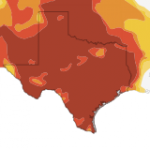The State of Texas Irrigation: More Efficiency Amid Less Water

Texas A&M AgriLife Extension Services
The A&M AgriLife Irrigation map shows large amounts of agricultural irrigation used in the Texas panhandle, while water demands in Central and East Texas are primarily from municipal users.
Texas irrigation is a big deal. The state is home to more than 10 percent of the irrigated acres in the country. Texas A&M’s AgriLife Extension looked into Texas’ agricultural water use in a recent report. It examines Texas’ economic dependence on irrigation, improvements in state-wide irrigation efficiency, and problems the state faces as water reserves dwindle.
Urban vs. Rural: Despite Texas’ large cities, most of the water in the state is used for agriculture, 57 percent of it. However, according to the report, farmers use water more efficiently than residential users. Less than 18 inches per year per acre is used on agricultural irrigation in Texas, while residents on average use 22 inches of water annually for their lawns.
Economic Implications: According to the report, 4.7 billion dollars in Texas agriculture relies on irrigation. In the High Plains alone, irrigated agriculture accounts for nearly 9 percent of the Texas economy, including 7,300 jobs. Growing food in Texas also secures availability to produce for the state, the report says, diminishing dependence on more costly imported goods.
Efficiency Improvements: The report also says that since 1970, Texas irrigation has greatly improved in efficiency. Much of that improvement has come from using better sprinkler systems, like center pivot systems and low pressure sprinklers. Farmers are also using networked weather stations to plan out the most efficient times to water on their crops. In fact, agricultural water use in the state has remained at a steady level, the report says, since the 1970s, while yields have increased.
Though the report cites advances in irrigation efficiency, it also acknowledges the need for more improvement. The state population is projected to double in the next 50 years, and municipal needs are already straining agricultural use in some parts of the state. Texas aquifer reserves are diminishing while the residential demand for water is increasing and droughts are becoming more frequent. Moreover, the demand for produce in the state will grow with population growth, increasing the need for more agricultural irrigation, the report says.
You can read the report in full over at the Texas Water Resources Institute.

